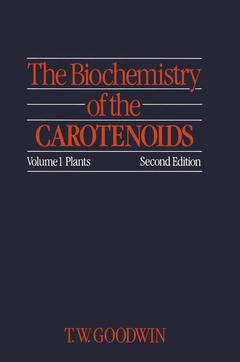Description
The Biochemistry of the Carotenoids, Softcover reprint of the original 1st ed. 1980
Volume I Plants
Authors: Goodwin T., Goodwin T.
Language: English
Keywords
Oxidation; bacteria; biochemistry; enzymes; evolution; growth; metabolism; methylation; photosynthesis; synthesis
Approximative price 52.74 €
In Print (Delivery period: 15 days).
Add to cart
Publication date: 10-2011
378 p. · 15.2x22.9 cm · Paperback
378 p. · 15.2x22.9 cm · Paperback
Description
/li>Contents
/li>
The carotenoids are not only amongst the most widespread of the naturally occurring groups of pigments, but probably also have the most varied functions; witness their known roles in photokinetic responses of plants, in phototropic responses of fish and as vitamin A precursors in mammals and birds. Pigments with such wide distribution and such diverse functions are obviously of great interest to biological scientists with very different specializa tions, especially as it is unlikely that the study of the functions of carotenoids is anywhere near complete. The primary aim of the present work is to discuss the distribution, bio genesis and function of the carotenoids throughout the plant and animal kingdoms in such a way that, because of, rather than in spite of its bio chemical bias, it will be of value to workers interested in all the biological aspects of these pigments. The biochemical approach is considered the most effective because, generally speaking, most progress in the study of carotenoids in living material has been achieved using biochemical techniques, be they applied by zoologists, botanists, entomologists, microbiologists or other specialists; what is even more important is that a consideration of the present position makes it certain that further fundamental progress will also be made along biochemical lines.
1. NATURE AND PROPERTIES.- 1.1 Introduction.- 1.2 Nomenclature and structure.- 1.3 Isolation and purification.- 1.4 Physical properties.- 1.5 Chemical properties.- 1.6 Addendum.- 1.7 References.- 2. BIOSYNTHESIS OF CAROTENOIDS.- 2.1 Introduction.- 2.2 General pathway to lycopene.- 2.3 Further reactions of lycopene.- 2.4 Insertion of oxygen into carotenoids.- 2.5 Acetylenic, allenic and refrocarotenoids.- 2.6 C30 carotenoids.- 2.7 References.- 3. FUNCTIONS OF CAROTENOIDS.- 3.1 Introduction.- 3.2 Photosynthesis.- 3.3 Photoprotection.- 3.4 The xanthophyll cycle.- 3.5 Phototropism.- 3.6 Phototaxis.- 3.7 Sporangiophore formation.- 3.8 References.- 4. CAROTENOIDS IN SEED-BEARING PLANTS-PHOTOSYNTHETIC TISSUES.- 4.1 Qualitative distribution.- 4.2 Quantitative distribution.- 4.3 Localization.- 4.4 Etiolated seedlings.- 4.5 Mutants.- 4.6 Synthesis in germinating seedlings.- 4.7 Effect of environment on synthesis in leaves.- 4.8 Biosynthesis.- 4.9 Regulation of synthesis.- 4.10 Metabolism.- 4.11 Plant tissue cultures.- 4.12 Parasitic and saprophytic plants.- 4.13 Aquatic higher plants.- 4.14 References.- 5. CAROTENOIDS IN HIGHER PLANTS.- 5.1 Reproductive tissues.- 5.2 Roots.- 5.3 References.- 6. MOSSES, LIVERWORTS AND SPORE-BEARING VASCULAR PLANTS.- 6.1 Bryophyta - mosses and liverworts.- 6.2 Tracophyta - spore-bearing vascular plants.- 6.3 Function.- 6.4 References.- 7. ALGAE.- 7.1 Nature and distribution.- 7.2 General factors controlling synthesis.- 7.3 Carotenoids, algal taxonomy and evolution.- 7.4 References.- 8. FUNGI.- 8.1 Distribution.- 8.2 General factors controlling synthesis.- 8.3 Function in reproduction.- 8.4 References.- 9. NON-PHOTOSYNTHETIC BACTERIA.- 9.1 Introduction.- 9.2 Distribution.- 9.3 Localization of carotenoids.- 9.4 Factors controlling synthesis.- 9.5 Biosynthesis of C30 carotenoids.- 9.6 Biosynthesis of C45 and C50 carotenoids.- 9.7 Formation of carotenoid glucoside esters.- 9.8 References.- 10. PHOTOSYNTHETIC BACTERIA.- 10.1 Distribution.- 10.2 Localization of carotenoids.- 10.3 General factors controlling synthesis.- 10.4 Biosynthesis.- 10.5 References.- 11. BIOGEOCHEMISTRY OF CAROTENOIDS.- 11.1 Introduction.- 11.2 Fresh water deposits.- 11.3 Ocean deposits.- 11.4 References.
© 2024 LAVOISIER S.A.S.
These books may interest you

Carotenoids in Photosynthesis 52.74 €



